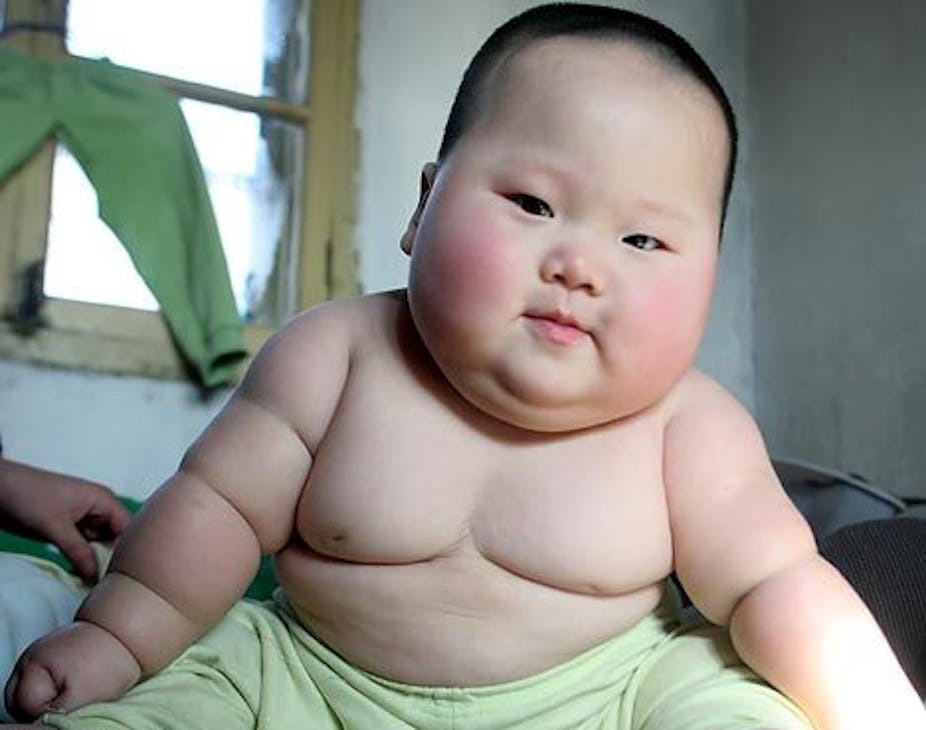A study recently published in the British Medical Journal (project Viva) has found that children born by caesarean section have a higher rate of obesity at age three than children born naturally. At first glance, how someone is born seems unlikely to cause obesity, so should expectant mothers considering a caesarean birth be worried?
The study recruited women during early pregnancy and then followed their children after birth (1,255 in total). Data were collected on a wide range of lifestyle and health factors from both parents and children.
Just over 20% of the children were born by caesarean section. Even after accounting for differences in birth weight and the mothers’ pre-pregnancy weight, infants born by C-section had twofold higher odds of developing obesity. The authors postulate that a caesarean birth somehow alters our biology in such a way that there’s a greater risk of developing obesity.
A very basic view of obesity biology is that it’s a consequence of skewed energy balance – if you pump in more calories than your body needs, it will store the excess energy as fat. Although there’s a lot of truth in this model, it’s a gross oversimplification of how our bodies work. It certainly offers no explanation for why rates of obesity should differ between children born by different routes.
So we need to consider what other factors are involved in obesity and how they might relate to birth mode. The prime candidate among these is gut microbes.

Obesity can be readily induced experimentally by feeding a high-calorie diet to mice. This makes it sound like a cut-and-dried case for diet being the main factor. But the microbes that live in the gut (the gut microbiota) also contribute to our nutrition.
The involvement of gut microbiota in nutrition has been tested by keeping mice delivered by caesarean section in germ-free isolators to have them grow up with no microbes. Researchers found diet-induced obesity was extremely difficult to generate in the absence of microbes.
The killer experiment, however, was when researchers re-introduced microbes into these previously germ-free mice. Mice that were colonised with microbes from fat mice (who’d been fed the high-calorie diet) put on a lot more weight than those that were colonised by microbes from lean mice. This indicates that the microbes in our gut influence how much of the food we eat actually gets turned into fat.
So the risk factor is what gut microbes you have and what we really need to be asking is whether a caesarean birth change our gut microbiota. Addressing this question requires you take a great interest in poo, since much of it is basically gut microbes.
In healthy adults, the microbial community is stable over time, but individually distinctive – each of us has a unique collection of microbial mates. Even a brief sensory survey of healthy people pooing will confirm we all have individual differences.
How we get these differences is essentially a combination of what microbes we are exposed to (our environment), what food we give them (our diet) and time (our developmental stage). Babies born by caesarean section will definitely have a different initial exposure to microbes and this latest study forces us to consider the possibility that this initial difference could cause lifelong differences that predispose some to obesity.

Although birth is when we first encounter microbes, the process of acquiring a stable gut microbiota takes time. As any parent knows, an infant’s poo will change dramatically in texture, smell and even colour over the first year and introducing anything new to the diet often precedes an interesting experience. A stable microbial community isn’t formed until we have a fully developed immune system and an adult diet pattern – well after age three.
To assess the risks of a caesarean birth for later obesity we need to know the relative importance of birth mode and postnatal environment on microbial colonisation. Studies in both animals and humans suggest that diet and environment over the postnatal period are more important than events immediately around birth.
Those aspects of the postnatal environment that appear most important are infant diet (especially breastmilk as opposed to formula milk) and the gut microbiota of the people most closely exposed to an infant (both parents, any siblings and childcare).
Interestingly, the Project Viva study also found significant differences between paternal and maternal body mass index (children delivered by caesarean were more likely to have overweight parents) and breast-feeding patterns (children delivered by natural birth were more likely to have initiated breast-feeding and to have been breastfed for longer).
This fascinating study shows how environmental factors influence our insides. Whether caesarean deliveries drove the difference in obesity observed in the Project Viva cohort or were simply associated with other postnatal environmental factors is a question that requires further study. For now, I wouldn’t let worry about obesity trump other reasons for considering a caesarean birth.

